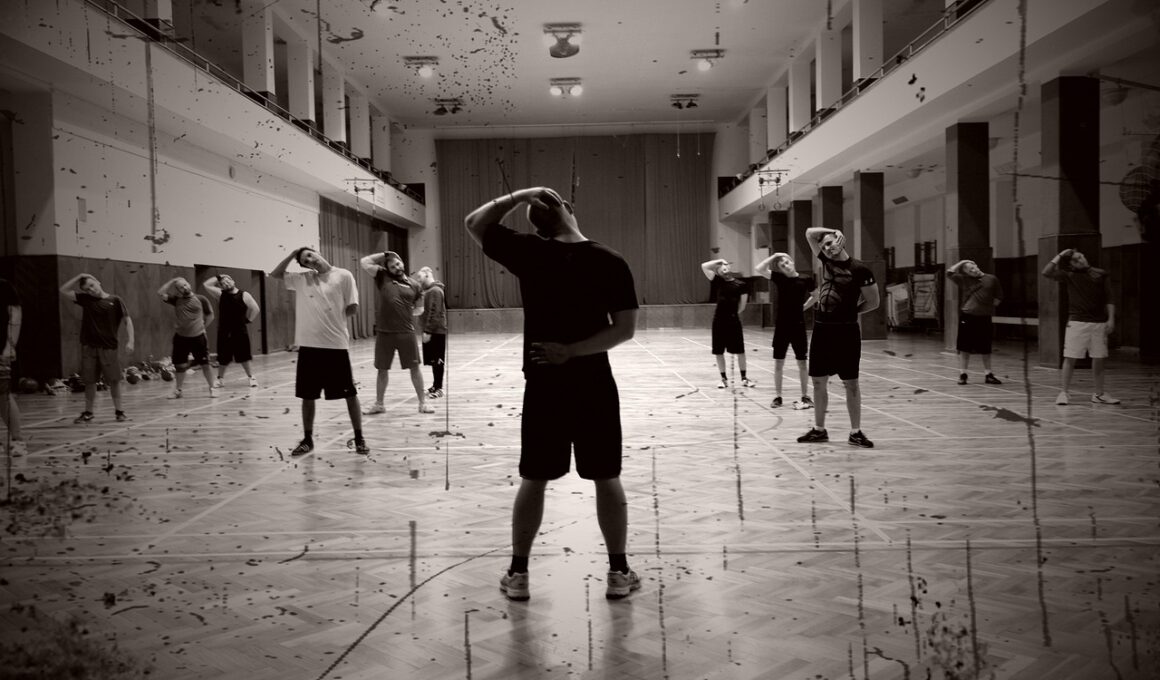Warm-Up and Activation Exercises for Tennis Strength Training
Before stepping onto the court, warming up is essential for optimal performance in tennis. These exercises prepare your body for the dynamic movements required in the game. Incorporate a combination of flexibility, strength, and activation exercises into your routine. Start with 5-10 minutes of light cardio, like jogging or skipping, to raise your heart rate. Follow up with dynamic stretches focusing on major muscle groups. This might include leg swings, hip circles, and torso rotations. Activation exercises are crucial as they engage your muscles and enhance coordination. Great options include glute bridges, monster walks with resistance bands, and shoulder mobilization drills. Ensure you maintain proper form and control throughout each movement. This increases effectiveness and reduces the risk of injury. A well-structured warm-up routine targets not only the muscles used in tennis but also improves overall athletic performance. This warm-up strategy promotes better blood flow, which can enhance your energy levels. Invest time in your warm-up to enjoy improved swings, footwork, and agility during your matches, setting the stage for success on the tennis court.
Dynamic stretching is integral to a comprehensive warm-up routine for tennis players. It’s critical not to skip this part because it enhances mobility and flexibility, preparing the body for strenuous activity. Consider movements like forward lunges with a twist or side lunges, which mimic the patterns in tennis. Performing these stretches increases blood flow to muscles and improves range of motion. Additionally, upper body dynamic stretches such as arm circles and shoulder dislocations can significantly enhance your performance. The goal is to gradually increase the body’s temperature and engage the neuromuscular system. Notably, dynamic stretches are best performed before matches rather than static stretches, which are more beneficial post-exercise when muscles are warm. This technique is essential for optimizing movement efficiency. Incorporating these stretches enhances muscle recruitment, which can benefit your swing and serve. A well-constructed set of dynamic stretches can not only prepare you physically but also create a positive psychological state before competition. Hence, always prioritize this warm-up element within your tennis training regimen to take full advantage of your body’s capabilities during matches.
Strength Activation Techniques
To maximize your tennis performance, strength activation exercises should be an essential component of your warm-up. They emphasize the engagement of key muscle groups, especially those required for powerful strokes and rapid movements on the court. Key exercises include resistance band walks, clamshells, and medicine ball tosses. These movements develop strength and enhance muscle coordination, which directly impacts your on-court agility. Always ensure you focus on maintaining proper form to prevent injury. When performing clamshells, for instance, keep your knees bent at 90 degrees and your feet together throughout the movement. Incorporating activation exercises also educates your brain-muscle connection, optimizing your body’s response to demanding tennis gameplay. Perform two to three sets of each activation exercise with moderate repetitions. Always consider your body’s physical limits, adjusting movement intensity accordingly. Remember to engage your core muscles, as a strong core contributes significantly to improved stability and control. These activation techniques are invaluable for athletes looking to gain an edge in their tennis performance, helping to improve the efficiency of each movement during matches.
The importance of proper footwork cannot be understated in tennis; hence, warm-up drills focusing on agility can be incredibly beneficial. Incorporating ladder drills, cone sprints, and quick lateral movements ensures your foot coordination is primed for action. Start with ladder drills that emphasize quick foot placement, such as in-and-out patterns, encouraging fast and nimble steps. This training will aid in developing quick reflexes, necessary for responding to agile plays during a match. Combine these drills with cone drills, setting up a course that requires rapid directional changes, simulating the court’s dynamic nature. Additionally, perform shuttle runs to enhance your acceleration and deceleration, both crucial in tennis. Adequate warm-up exercises for footwork enhance your ability to cover the court efficiently. Overall, incorporating agility drills into your warm-up routine sharpens your skills. This specialized training leads to more effective movement, making you a more formidable opponent. Always remember, being fleet-footed can make a significant difference in intercepting difficult shots, improving your overall game.
Incorporating Core Exercises
The core plays a pivotal role in tennis performance, so incorporating core-strengthening exercises into your warm-up is critical. Engaging your core stabilizes your body during strokes, promoting better balance and control. Effective core exercises include planks, medicine ball Russian twists, and side planks. Start your warm-up with 30 seconds to a minute of planks, focusing on maintaining a neutral spine. This activation promotes stability throughout your entire swing. Follow up with medicine ball Russian twists, allowing you to practice rotational stability, mimicking the twisting actions in tennis. Side planks also serve to strengthen your obliques, essential for lateral movements on the court. Aim to hold each position for about 30 seconds or more. Consider integrating these exercises into your routine as part of a full-body warm-up. Furthermore, emphasize quality over quantity—perform each exercise with perfect form. A strong core will lead to more powerful serves and returns, significantly enhancing your performance on-court. Lastly, always listen to your body and avoid pushing through discomfort while activating your core.
Once you have completed activation and strength exercises, transitioning into sport-specific movements is vital. This phase of your warm-up prepares your body for the exact motions you’ll perform during tennis matches. Emphasize movements that reflect your game patterns, such as forehand and backhand swings, shadowing practices without the ball. These mimic the explosive actions you will exert. Incorporate dynamic movements, including lunges with a twist to simulate your footwork during matches. As you practice these motions, focus on controlling your body and maintaining a fluid rhythm. This practice will activate the muscle memory required during gameplay, allowing for a smooth transition and execution. Additionally, consider performing short sprints to get your body accustomed to the quick bursts of energy needed in tennis. After all, tennis requires short but intense bursts of speed and agility. Always remember, a focused warm-up allows you to translate your prepared activation into effective performance. Ultimately, this will boost confidence as you enter competitive arenas, improving overall gameplay quality.
Cool Down and Recovery
Post-match, it’s essential to incorporate cooldown exercises to promote recovery and reduce muscle soreness. This phase helps in decreasing heart rates gradually and restoring your body’s resting state. Start with light jogging or brisk walking, allowing your body to transition out of higher intensity. Afterward, focus on static stretches that target the major muscle groups involved in tennis. Key muscles include the hamstrings, quadriceps, shoulders, and back. Holding each stretch for approximately 15-30 seconds can significantly enhance flexibility and recovery. Stretch each major muscle group thoroughly, ensuring you’re not holding onto tension. This routine will not only alleviate any tightness but also contribute to long-term flexibility benefits. Remember, hydration and nutrition play a crucial role in recovery, so consider consuming drinks rich in electrolytes and protein. Effective cooldown strategies help in healing and prevent injuries that may occur without proper recovery. Ultimately, developing a complete tennis fitness routine, including warm-ups, drills, and cooldowns, enhances overall performance, leading to a more enjoyable and successful tennis experience.
In conclusion, a dedicated warm-up and activation routine is essential for every tennis player, regardless of skill level. By incorporating various exercises tailored to your sport, you improve not only your performance but also minimize the potential for injuries. Emphasizing dynamic and strength activation enhances your agility, power, and coordination on the court. Be sure to integrate these elements into a comprehensive warm-up strategy that suits your individual needs. Additionally, consider varying your routine to keep it engaging and effective. Always listen to your body and modify exercises accordingly, prioritizing any necessary adjustments to optimize your performance. Building a habit of prioritizing warm-ups could distinguish between a successful match and a challenging one. Ultimately, commit to this practice to enhance your competitive edge. Every successful player understands the significance of preparation. Take these steps to ensure you’re primed for your tennis sessions. Engaging in a robust warm-up routine can ignite your potential and elevate your game. Lastly, remember to cool down properly to ensure long-term benefits, establishing a complete approach to tennis fitness. Make warm-up exercises a staple in your training to reap their full rewards.


